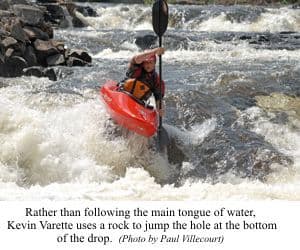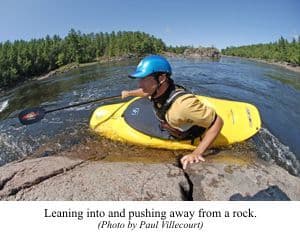Handling Rocks
The following is a modified excerpt from Ken Whiting's book, 'The Ultimate Guide to Whitewater Kayaking'

People are often surprised to learn that rocks aren't always your enemies on the river. Rocks can provide valuable, calm eddies amidst the chaos of a rapid. Rocks also slow down the flow of the main current, create weak spots that allow you to escape from holes, and provide ramps or jumps that you can use to clear nasty pourovers. Of course, rocks can also be pretty painful in a lot of different ways if hit unintentionally, so they must be treated with caution. In this article, we're going to look at some of the basic rules for dealing with rocks.
When approaching a rock, you have a couple of options. Of course the first option is simply to avoid it, but if that's not possible, you need to take actions that will probably fight your natural instincts. The natural response to colliding with a rock is to turn sideways and lean away from it, which puts your kayak between yourself and the rock. Unfortunately, this action will have some very undesirable results, as leaning away from a rock means leaning upstream. As soon as your kayak hits the rock or the pillow of water bouncing off the rock, current will pile up on your upstream edge and flip you mercilessly. You'll now find yourself upside down against a rock, in what is a very difficult position to roll. So what should you have done?
When drifting into a rock that can't be avoided, you need to keep your boat tilted downstream to prevent your upstream edge from catching the main current. In lighter current, or when dealing with lower-angle, rounded rocks, this might simply mean holding an edge and bouncing into the rock or its pillow at the ready with a brace. You might even get broached and have to push yourself laterally off the rock with your downstream hand. In faster current, or when the rock is more vertical, you may need to lean your whole body into the rock while holding your boat on edge. You may also need to push yourself laterally off the rock with your downstream hand. Of course every situation is different, but the key is always to keep your upstream edge from catching water. Lean into that rock!

Rocks that are just below the surface can also wreak havoc on unsuspecting paddlers. With experience, you should never really be caught unaware by a rock that is just below the surface. Your river reading skills should allow you to recognize it before hand. If your path does take you over a submerged rock then you should try to hit the rock as straight on as possible, with enough speed to drive over top of it. Submerged rocks can also do damage to poorly placed paddles. Remember that you need to be reading the water all around you, not just directly in front of your kayak. Doing so can easily save you the expense of having to buy a replacement blade for your paddle.
The last rocks that we're going to consider are those under the water that can have a real "impact" on an upside-down paddler. Fortunately, these are the most seldom encountered rocks. In fact, many paddlers will never make acquaintances with an underwater rock. In the event that you do meet a rock underwater, there are a few things you need to keep in mind in order to minimize the impact. Of course your first line of defence is to roll up as quickly as possible. The less time you spend underwater, the better. This is where the back deck roll is particularly effective. But, if rolling isn't an option, your most protected position while upside down is tucked forward against your kayak. Your helmet and life jacket will take the brunt of any impact with rock. This is one of the reasons that you are taught in the beginning to move to this protected position whenever upside down, whether you plan to roll, wait for a rescue, or wet-exit. Problems can arise when you flip while leaning back, as moving to this protected position requires sitting right up and then tucking forward, which puts you in a very vulnerable position for a brief moment. If faced with this dilemma, keep your paddle shaft and your arms in front of your face as a shield while moving into the protected forward position.
Ken is a World Champion Kayaker and the author and producer of an award winning series of instructional kayaking books and videos. He was recognized by "Paddler Magazine" as one of their 'Paddlers of the Century'. For more information, visit www.helipress.com.